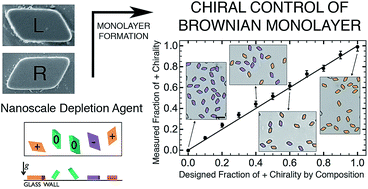Controlling enantiomeric populations in fluctuating Brownian monolayers of chiral colloids†
Abstract
An ideal parallelogram platelet, although achiral in 3D, has an identifiable chirality when confined in a 2D monolayer. We lithographically fabricate microscale parallelogram platelets, disperse them in an aqueous surfactant solution, and allow them to settle towards a lower glass wall. To reduce the thermal-gravitational height, we add polystyrene nanospheres as a depletion agent to create a depletion attraction between the parallelograms and the wall. Surprisingly, by increasing the volume fraction of the depletion agent, we show that a nearly enantiopure monolayer can be created. We explain this by developing a model of 2D monolayer formation based on anisotropic facial attractions; one face of a platelet is more strongly attracted to the wall than the other as a consequence of an anisotropy introduced by the lithographic process. We study enantiopure Brownian systems of parallelograms as a function of particle area fraction and show that oblique chiral crystals form at high densities. By mixing parallelogram platelets printed in opposite senses, we also dictate the chiral ratio in the monolayer over the entire possible range. This approach is not limited to parallelograms and provides a means for tuning the chiral ratio in fluctuating 2D monolayers composed of a wide variety of chiral shapes.


 Please wait while we load your content...
Please wait while we load your content...